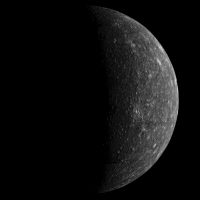Mercury
 |
Origin of name
Naming convention
ESA mission |
BepiColombo
BepiColombo, an ESA mission in cooperation with Japan, will explore Mercury, the planet closest to the Sun. Europe's space scientists have identified the mission as one of the most challenging long-term planetary projects, largely because Mercury's orbit so close to the Sun makes the planet difficult for a spacecraft to reach and difficult to observe from a distance. Scientists want to study Mercury because of the valuable clues it will provide in understanding how planets form.
Physical Properties
| Property | Unit | Value | Earth = 1 |
| Equatorial radius | km | 2439.7 | 0.383 |
| Polar radius | km | 2439.7 | 0.384 |
| Flattening | 0.0000 | 0.000 | |
| Mass (x1024) | kg | 0.3302 | 0.055 |
| Volume (x1010) | km3 | 6.083 | 0.056 |
| Mean density | kgm-3 | 5427 | 0.984 |
| Surface gravity at equator | ms-2 | 3.70 | 0.378 |
| Escape velocity | kms-1 | 4.3 | 0.384 |
| Magnetic field at equator (x10-4) | T | 0.0033 | 0.01 |
| Magnetic dipole moment (x1012) | Tm3 | ~ 5.54 | ~ 0.0007 |
| Tilt of dipole axis | ° | 14 | |
| Dipole field centre offset from planet centre (equatorial radii) | 0.05 |
Orbital Parameters
| Property | Unit | Value |
| Perihelion (x106) | km | 46.00 |
| Aphelion (x106) | km | 69.82 |
| Mean distance from the Sun (x106) | km | 57.91 |
| Mean distance from the Sun | AU | 0.387 |
| Eccentricity | 0.2056 | |
| Sidereal orbit period | d | 87.969 |
| Sidereal rotation period | d | 58.65 |
| Length of day | d | 175.94 |
| Orbit inclination to Ecliptic | ° | 7.00 |
| Mean orbital velocity | kms-1 | 47.87 |
| Maximum orbital velocity | kms-1 | 58.98 |
| Minimum orbital velocity | kms-1 | 38.86 |
| Axial tilt | ° | 0.01 |
Notes
-
Sidereal orbit period
The time taken by the planet to complete exactly one orbit around the Sun with respect to the celestial sphere. -
Sidereal rotation period
The time in which the planet rotates around its axis exactly 360° with respect to the celestial sphere. -
Length of a day
Defined as the time between two successive sunrises over the meridian. -
Magnetic dipole moment
Calculated as the ratio of the magnetic field strength at the equator divided by the cube of the equatorial radius.
